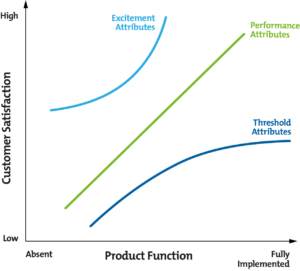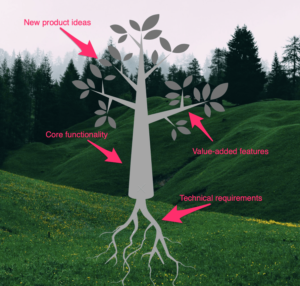7 Prioritization Frameworks That Streamline Product Development

Building strong customer relationships is tied directly to your ability to provide continual value via the product experience. Doing so requires a strong sense of not only what customers want from your product but also when they want it. Which is why it’s no surprise that 32% of product managers list planning and prioritizing as their biggest challenges, according to a 2019 ProductPlan study.
Because anticipating a customer’s needs is one thing—providing valuable solutions throughout their user journey is another. Product prioritization helps your team deliver continual value with each release. And the first step to getting a handle on this process is choosing the right product prioritization framework for your team.
Each framework has its own unique benefits, so you don’t need to choose just one. Understanding what frameworks are available, how they help you determine feature and release priorities, and what ways they impact your team is the key to building a product development process that provides real-world results.
1. User Story Mapping
Story mapping is a simple prioritization framework focused on the user experience. Instead of building out your product priority based on internal goals and objectives, story mapping connects feature releases to the actions people take throughout their product journey. This helps your team connect with customers’ needs, wants, and desired outcomes on a deeper level and builds empathy across your team.
To use this prioritization framework, you create horizontal and vertical axes:
- The horizontal axis represents touch points in the user journey
- The vertical axis represents the priority of each touch point

This example breaks down the user experience of managing, editing, and sharing a document, from signing in to completing the task. This is a simple way to map out your understanding of the customer journey on a deeper level. And it helps your team visualize specific user actions as well as potential pain points along the way.
User story mapping helps you identify where you can add value throughout the experience, making it clear which actions require the most work or cause the most frustration. But as a strictly user-focused framework, story mapping doesn’t account for nonuser pressures like resource availability or development time. This framework works best when you combine it with others that focus more on the business side of product development.
2. RICE
RICE is a product prioritization framework created by Intercom. The acronym stands for reach, impact, confidence, and effort. Thinking about your product in terms of these four aspects helps you build a comprehensive picture of any project’s overall impact in simple mathematical terms.
Each factor gets assigned a monetary value based on your specific product or feature release:
- Reach: The people affected in a given period. For example, 1,000 new users in onboarding.
- Impact: The impact a new product has on these people. Intercom recommends using the following scale:
- 3 for a massive impact
- 2 for a high impact
- 1 for a medium impact
- 0.5 for a low impact
- 0.25 for a minimal impact
- Confidence: Your confidence in the Reach and Impact scores. Intercom uses these percentiles:
- 100% for high confidence
- 80% for medium confidence
- 50% for low confidence
- Effort: The work required to complete the project, measured in person-months (the amount of work one team member can accomplish in one month)
Taking these four factors into account, you can calculate your product’s overall RICE score:
Reach x Impact X Confidence / Effort = RICE Score
Using the example above, let’s say your team is 80% confident that they’ll make a high impact (2) on all 1,000 new users in onboarding, and the project will take three person-months of effort to complete. Then the calculation will look like this:
1,000 x 2 x 80% / 3 = 533
Now, let’s say you have another feature idea that has a RICE score of 324. The RICE model tells you to prioritize the 533 RICE score feature first because it has more of an impact on your customers.
Just keep in mind that the RICE model ignores outside pressures such as competitor launches, market shifts, or other business pressures. So it’s important to look at it in the context of your market as a whole.
3. The Kano Model
The Kano model looks at product prioritization through the lens of two competing factors: customer satisfaction vs. overall functionality. Basically, it’s a cost-benefit analysis framed around the impact of a new feature release on customer delight.
Satisfaction scores go from low to high, and functionality scores get broken down into three categories, based on how well customers feel their needs are met:
- Threshold attributes: The basic features that customers expect to use when engaging with your new product or feature. These are your table stakes.
- Performance attributes: Additional features that customers would like to see as a part of your new product. Basically, they’re what makes your product interesting.
- Excitement attributes: Fun and engaging features that customers rave about in reviews. They’re what differentiates your product from others on the market.
Once you interview current customers, you plot their answers on vertical and horizontal axes:
- The vertical axis represents customer satisfaction.
- The horizontal axis represents how well a product meets customer needs.

Thinking about prioritization in this way helps your team build their understanding of what makes a delightful product experience. The idea is to see how much time and how many resources your team should invest in each of the three product attributes.
One drawback of the Kano model is the time it takes to compile enough survey responses. And if you’re asking about features you intend to build in the future, it can be difficult for customers to understand something they’ve never used.
4. MoSCoW Method
The MoSCoW method helps you prioritize features based on the four criteria that make up its name: Must-haves, Should-haves, Could-haves, and Won’t-haves. This helps you look at the overall impact of various features based on how necessary they are for either your business or your customer.
As prioritization frameworks go, this method is one of the best at helping to nail down exactly what is required for your feature to be release-ready:
- Must-haves are the aspects of your product that are necessary for it to function properly.
- Should-haves are the features you want to include that help your product stand out.
- Could-haves are features that will add value to the product experience but not detract from it if left out.
- Won’t-haves are your ideas that aren’t incorporated in the current release.
Using this method helps you figure out core functionality for your upcoming release while also making it clear how you’ll be able to differentiate your product from others in the market.
Let’s say you’re building an email-campaign component to your marketing automation platform. Then your MoSCoW analysis would look something like this:
- Must-haves: High deliverability, open- and click-rate analytics, scheduling functionality
- Should-haves: HTML and CSS customization, user-specific campaign triggers, email templates
- Could-haves: Ecommerce integration, subscriber profile management, drag-and-drop email design tool
- Won’t-haves: Push notifications, embedded media capability, landing page builder
The must-haves and should-haves are core features that will help your product function and will differentiate it from the rest of the market. And the could-haves help you determine what features to focus on once this core functionality is created. The wont-haves can be ideas to enhance the product or experience in the future, or potential upgrades to build as your company and product suite evolves.
Just keep in mind that this prioritization framework works best when focusing on individual releases. It lacks the long-term vision of other methods.
5. Value vs. Effort
This prioritization framework looks at the two core drivers of product development—the value of a new product for your business/the customer and the amount of work it takes to build. Using this framework helps you assign scores to each of these factors based on input from your team.
This is an excellent framework for helping your team form a collective sense of priority. It’s a simple way to encourage open and honest conversations on how each team member thinks about product priority and strategic direction.
Value vs. effort calculations are also one of the easiest to complete, requiring your team to answer only two questions:
- How valuable is the product/feature for users?
- How difficult is the product/feature to build?
Every team member ranks their answer to each question from 1 to 5, and then you average out the difference based on their feedback. It’s a great way to identify low-hanging fruit and scope the work required for any upcoming project. A product or feature that is highly valuable for customers and easy to build should be prioritized before something that is less valuable or more difficult to accomplish.
This framework’s core drawback is that it becomes difficult to use as your product suite grows in size. The more features you want to rank, the more subjective both the value and effort scores become, leading your team to form a cognitive bias based on too much input.
6. Opportunity Scoring
This is a simple prioritization framework that stems from Anthony Ulwick’s Outcome-Driven Innovation. In it, your team asks users two questions about an existing or upcoming feature:
- How important is this product or feature to you?
- How satisfied are you with what our company currently offers?
Survey respondents give answers on a scale of 1-5 or 1-10, depending on your team’s preference. From there, you’ll calculate the overall opportunity score using the following formula:
Importance + (Importance – Satisfaction) = Opportunity
Higher importance scores and lower satisfaction scores represent your biggest opportunities. This makes sense logically because customers buy products to help themselves accomplish a specific task or affect a particular process for their team. If that product or feature is important but poorly executed, that leads to lower engagement and a lack of purchase intent.
Opportunity scoring is a great way to take your customer’s pulse and understand which features are the biggest value drivers for your business.
7. The Product Tree
The product tree is somewhat more of a visualization exercise than a prioritization framework. Used alongside other methods, it helps your team get a better sense of how different products and features work together to impact your business goals.
The product tree is made up of a trunk, branches, roots, and leaves—each signifying a different aspect of your company’s product suite.
- Trunk: Core product functionality
- Branches: Value-added features
- Roots: Technical requirements
- Leaves: Upcoming ideas
There is no quantitative aspect to this framework, so it’s crucial that your team have a comprehensive understanding of customer needs and desired outcomes before you move forward with the exercise. Visualizing the product development process in this way not only is engaging but also helps your team think about the way your product or feature suite grows and evolves over time.

Say you’re in the process of planning out an update to the core functionality of your product—the trunk. As the product tree grows, your team notices that the infrastructure requirements—the roots—don’t scale as quickly as the rest of the project. That means you’ll need to take a step back and prioritize updates to these technical requirements before pushing the update live.
The act of “pruning the product tree” is a way to remove features that don’t add value to your business, whether it’s ideas that don’t add value to the customer experience or branches that aren’t realizing the type of value you expected after release.
Using this framework is a fun and engaging way to add a little bit of levity into your project management and increase interest with key stakeholders throughout your team.
Find the Prioritization Frameworks That Work for Your Team
No single framework will help you define priority for your team. To guide your team effectively, you need to combine prioritization frameworks to create a comprehensive picture of every feature release’s value, cost, and complexity. As your product development process evolves, understanding different ways to determine priority will help you build products that exceed expectations of value across the board.
__
For more information about Taplytics and how we help companies optimize their apps and websites, feel free to reach out – we’d love to chat!
